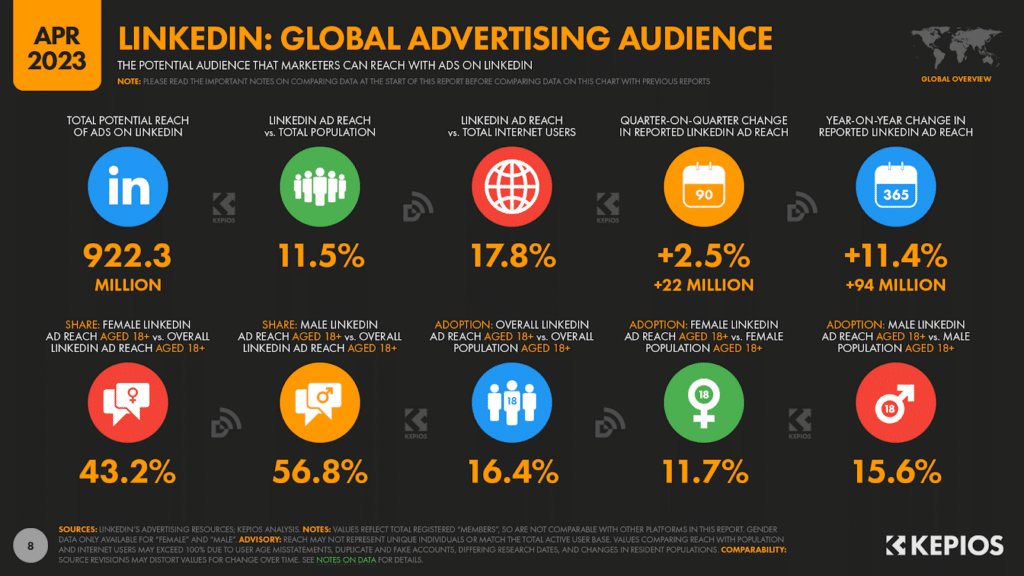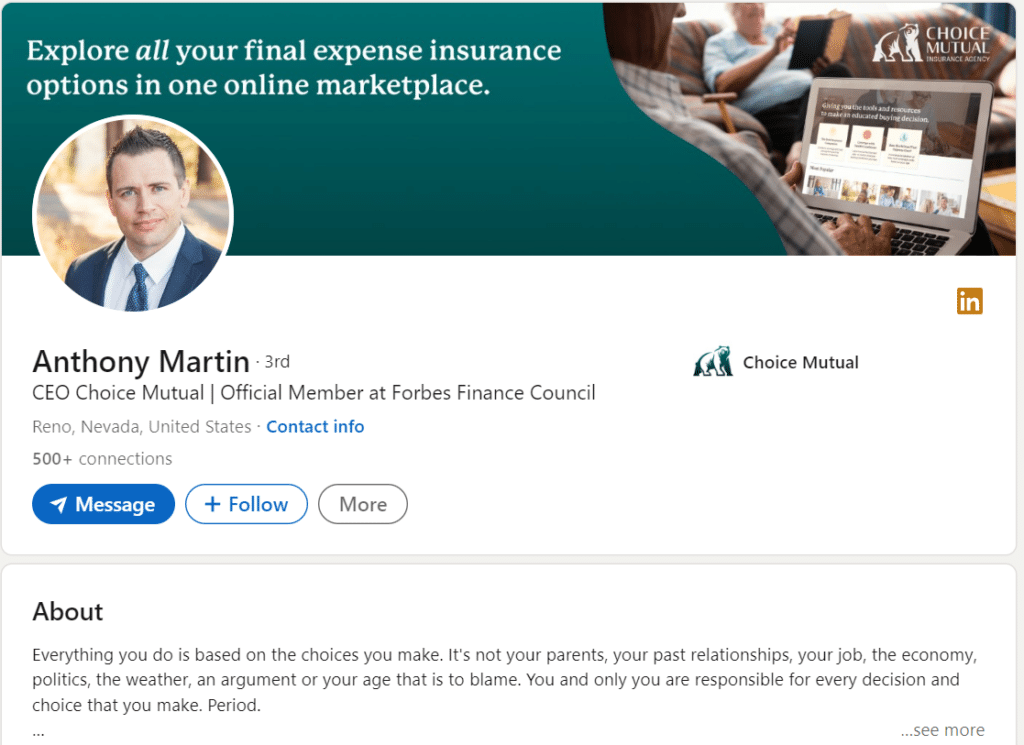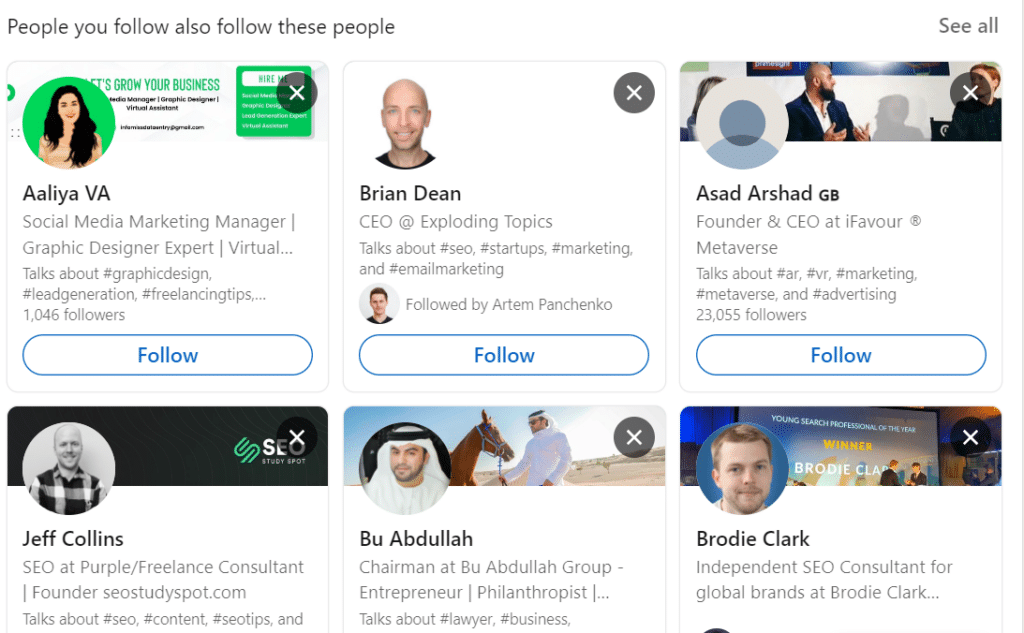An Overview of LinkedIn for Professional Networking
LinkedIn is a social networking channel for professionals and businesses looking to connect, communicate, and collaborate.
It serves as a digital hub for the following audience segments with varied goals on the platform:
- Job seekers exploring career opportunities
- Employers searching for prospective candidates
- Professionals seeking to advance their careers, networking with industry professionals, searching for jobs, and building their personal brand
- Businesses promoting their products and services
- Industry leaders aiming to establish and expand their professional brand and advance their careers by sharing insights and engaging with their network
- Organizations like educational institutions, nonprofits, and government agencies, using the platform to network, share initiatives, and collaborate on mission-aligned projects.
Here are some interesting LinkedIn marketing statistics you should be aware of:
- About 61 million people use LinkedIn to look for jobs weekly. Approximately 117 job applications are submitted every second on the social network, and eight people are hired on LinkedIn every minute.
- About 59 million businesses have LinkedIn pages with over 700,000 product pages on the platform. Pages that post weekly earn 5.6 times more followers than those that post monthly.

Through the LinkedIn platform, you can perform the following:
- Create and customize your LinkedIn profile
- Connect with various stakeholders
- Establish relationships with other professionals
1. Create and Customize Your LinkedIn Profile
To establish a solid online presence, begin by crafting a comprehensive LinkedIn profile.
This is your digital resume and an important part of your personal branding. Include detailed sections about your employment history, education, skills, and notable accomplishments.
This not only highlights your professional journey but also positions you as an expert in your field. Tailor your profile to appeal to your target audience, whether they are potential employers, collaborators, or clients.
Adding rich media like videos or presentations can further showcase your work and enhance your profile’s impact.
2. Connect with Various Stakeholders
LinkedIn enables you to connect with a diverse group of stakeholders, including work colleagues, classmates, industry peers, and potential employers.
Start by sending connection requests to relevant contacts in your industry. This initial step helps you expand your professional network and opens doors to opportunities.
Engage regularly with your connections through meaningful conversations and by commenting on their LinkedIn posts. This engagement is key in building lasting professional relationships.
3. Establish Relationships with Other Professionals
To deepen your professional relationships, actively share and comment on industry-related news, blog posts, and thought leadership articles. This type of content not only informs your network but also sparks discussions and positions you as a thought leader.
Engaging with other users’ content through likes, comments, and shares encourages reciprocal interactions, further solidifying your professional relationships.
Regularly updating your own LinkedIn posts with valuable insights can attract more followers and enhance your visibility in your industry.
If you follow these strategies, you can leverage LinkedIn for effective online networking and social media marketing, ensuring you connect with the right audience and maximize your professional potential.
How to Network on LinkedIn: 6 Practical Steps
Professional networking helps you establish stakeholder relationships, open doorways for many opportunities, and drive business growth and success. LinkedIn has become a go-to platform for professional networking. However, you must be wise enough to make the most of this platform.
As a CEO, here’s how to network on LinkedIn:
- Create a professional LinkedIn profile
- Set your networking goals
- Create LinkedIn connections in your industry
- Share content for professional engagement
- Post and engage in LinkedIn groups
- Monitor and measure your networking strategies
1. Create a Professional LinkedIn Profile
A LinkedIn profile is no longer an option—it’s a must nowadays. Whether you’re looking for a job, launching an e-commerce business, or expanding your network, create a compelling profile. However, ensure its utmost professionalism while making it as appealing and engaging as possible.
Look at the LinkedIn profile of Anthony Martin, CEO of Choice Mutual, as a perfect example of LinkedIn account:

Below are a few recommendations to build a strong LinkedIn profile:
- Choose a professional headshot for your profile picture
- Create a striking headline, highlighting your role and expertise
- Make the About section catchy & use it as your very own LinkedIn summary
- Develop a professional summary of the following:
- Employment experience
- Education
- Skills
- Licenses and certifications
- Courses
- Interests
- Recommendations
2. Set Your Networking Goals
Setting clear networking goals on LinkedIn tailors your strategy to meet specific objectives, whether you’re a job seeker, employer, industry leader, or business. As mentioned, every type of person has a different goal on LinkedIn.
As such, define your networking goals on LinkedIn. Be as specific and detailed as possible. Are you looking to learn from industry leaders, stay up-to-date with industry trends, or pursue business partnerships?
For instance, if you own a bookstore, you might use LinkedIn to connect with publishers and authors, as well as to find opportunities for co-promotions with other businesses that cater to book lovers. Your primary networking goal could be to establish connections that help diversify your inventory and create engaging in-store events.
Setting your goals at the onset will guide your networking activities. You can plan and implement your strategies based on these goals. They can make your networking efforts more purposeful. That will ultimately help you build your LinkedIn network more effectively.
3. Create LinkedIn Connections in Your Industry
Now, it’s time to connect with professionals and businesses in your industry.
Here’s how to get connections on LinkedIn:
- Target the right connections
- Send connection requests
- Nurture LinkedIn connections
A. Target the Right Connections
To effectively expand your professional network on LinkedIn, start by using the LinkedIn Advanced Search feature to pinpoint potential contacts by location, industry, job title, and education.
Here are some LinkedIn stakeholders to consider from the get-go:
- Industry leaders and influencers: Stay connected to catch trends and insights that can help you lead and innovate. Engaging with their content can also foster valuable partnerships.
- Potential business partners: Engage in groups and with individual profiles to explore collaboration opportunities that can expand your business’s reach.
- Current clients and potential leads: Keep in touch and share relevant content to stay on their radar and gently guide potential leads towards your services.
- Top talent: Use LinkedIn to find and connect with top talent, making your hiring process more efficient and targeted.
You can even follow some of the key players in your industry, as shown below:

Engage with LinkedIn Events and Webinars to meet and connect with these key stakeholders, leveraging these events to not only learn but also to initiate meaningful professional relationships.
B. Send Connection Requests
When sending connection requests, always personalize your approach. Include a note explaining how you found their profile, highlighting any common connections or shared interests, and clearly stating why you would like to connect.
This personal touch significantly increases the chances of your request being accepted. For more strategic networking, consider using LinkedIn’s Sales Navigator to tailor your requests even further.
This tool can help you understand the activities of potential leads and customize your message based on their recent professional achievements or posts.
C. Nurture LinkedIn Connections
Building a network isn’t just about making initial connections; it’s about maintaining and nurturing those relationships. Regularly interact with your connections’ content through likes, comments, and shares.
Use LinkedIn Messaging and InMail to continue conversations and share relevant content, showing genuine interest in their professional lives. Sales Navigator can also be useful here, as it provides insights into your connections’ activities, helping you to engage more thoughtfully and effectively.
4. Share Content for Professional Engagement
Content marketing has an impact on professional networking on LinkedIn because, in the digital world, everyone is online searching for information, products, and services. This means that offering valuable content can significantly enhance your visibility and credibility on the platform.
Of course, content creation applies to professional networking on LinkedIn. It’s best to share pieces of content on the platform, such as the following:
A. Industry Insights and Trends
Regularly analyze and comment on emerging trends and technological advancements in your industry. This establishes you as a forward-thinking professional who’s in tune with industry shifts and innovations.
B. Company News and Milestones
Use LinkedIn to broadcast significant company achievements, such as anniversaries, awards, or major project completions.
Take a look at this example from Michael Musandu, CEO Lalaland:

This not only keeps your network informed but also builds your company’s credibility and attract potential talent.
C. Leadership and Management Advice
Share personal insights and advice on leadership and management. This type of content resonates with other leaders and helps build a personal brand as a thoughtful and experienced executive.
D. Employee Spotlight and Company Culture
Regularly feature stories about your employees or unique aspects of your company culture.
Take a look at this post from Lawrence Masle, CEO UP THERE, EVERYWHERE:

This not only humanizes your brand but also makes your company more attractive to potential employees.
E. Educational Content and Resources
Provide value to your network by sharing educational resources such as whitepapers, webinars, or expert articles.
Wade Foster, CEO Zapier, has shared such a study about remote working:

This content demonstrates your commitment to industry growth and personal development.
F. Opinion Pieces
Express your views on relevant industry issues or societal trends. This can establish your voice in important discussions and spark meaningful engagement.




